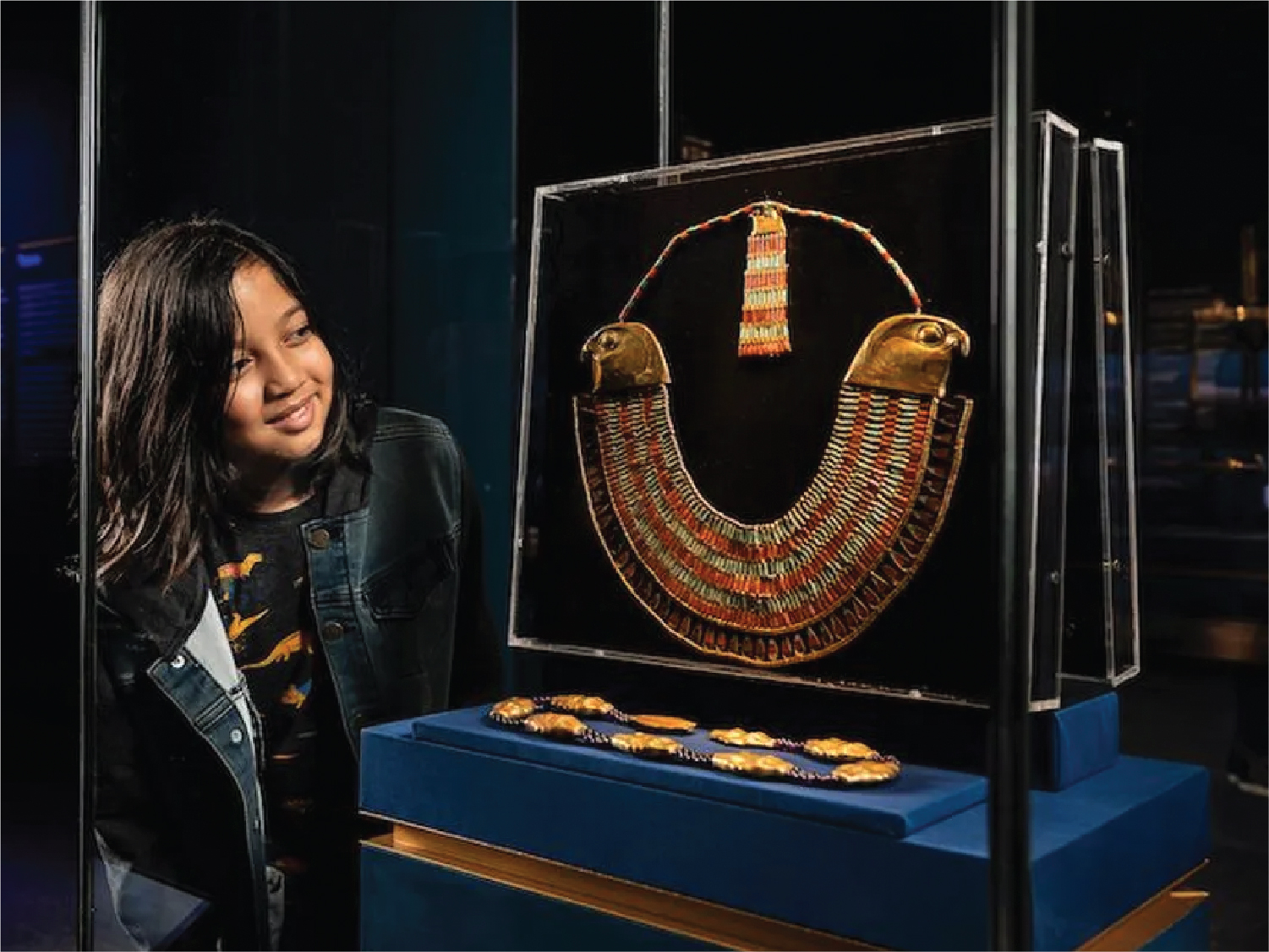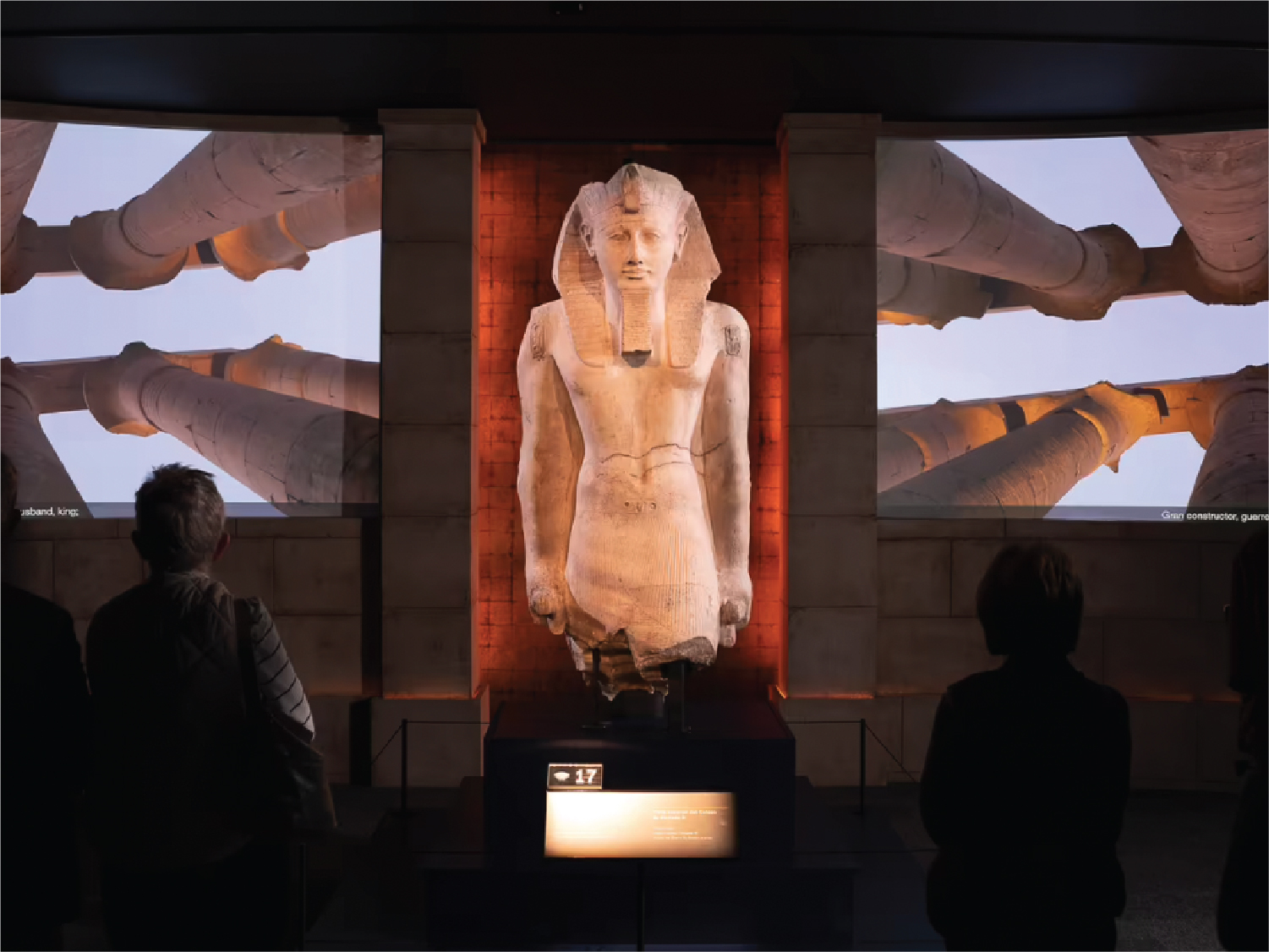
Among the almost 200 opulent ancient Egyptian artifacts in the new exhibition “Ramses the Great and the Gold of the Pharaohs,” curator Zahi Hawass says he’s been transfixed by one sculpture: an 8-foot-tall, red granite head of Ramses II dating to the 13th century B.C.
The commanding visage of Egypt’s most influential New Kingdom ruler, wearing the iconic white crown of Upper Egypt and a chin-strapped false beard, originally topped a colossal statue in a Memphis, Egypt, temple. Discovered there in 1888, the deified pharaoh’s likeness now greets visitors entering the de Young Museum’s immersive 12,000-square foot installation, opening Saturday, Aug. 20. The exhibition explores the reign of one of Egypt’s most powerful and longest-ruling monarchs; Ramses the Great ruled for 67 years and lived past age 90, a rare life span in the ancient world.
It’s the greatest collection of Ramses II objects ever to travel to the United States, including numerous items never loaned outside Egypt — sarcophagi, royal masks, sculpture, recently discovered animal mummies, amulets and magnificent jewelry — as well as a virtual reality component installed in the museum’s Piazzoni Murals Room.
Review: ‘Ramses the Great’ show in S.F. uncovers the ‘fine art’ in immersive experiences
“I really love that statue at the beginning of the exhibit,” an exuberant Hawass told The Chronicle by phone from Los Angeles before his trip to San Francisco, where he plans to give a free public lecture on Saturday. “When I look at his face, I imagine that I am talking to Ramses II. In fact, when I wrote the (exhibition) catalog, which includes more personal stories, it was as if Ramses was here in front of me, talking to me, telling me his story himself.
“He told me he was not just a ruler but a philosopher, a warrior, a peacemaker,” the famed archeologist and Egyptoloist continued, “a man who was so in love with Nefartari as a young man, he built for her the most beautiful tomb ever made for a queen.”
Now, if anyone else were to recount in such breathless fervor an imaginary conversation with the 3,000-year-old pharaoh known as Ozymandias in Greek texts, whose mummified body rests in Cairo’s National Museum of Egyptian Civilization, we might rightly question their hold on reality. But it somehow makes sense for a nostalgic showman like Hawass, whose career since working as a young inspector at the great pyramids has been guided by an unquenchable curiosity and sense of connection with Egypt’s epic past.
“When I heard a Ramses exhibition would be available to travel here, I jumped at the opportunity,” said Renee Dreyfus, de Young’s curator in charge of ancient art.
Hawass, former secretary-general of Egypt’s Supreme Council of Antiquities, is best known in the U.S. from his frequent television appearances on the Discovery Channel, Fox and the History Channel (“Chasing Mummies”). There seems to scarcely be media coverage involving ancient Egypt without Hawass’ involvement. He’s filmed CT scans of King Tut’s remains and his 2010 discovery of the tombs of the Khufu pyramid builders.
A man in perpetual motion at 75, Hawass hasn’t slowed a bit in spreading the gospel of Egypt’s past grandeur.
“I’m giving 23 lectures in America next May,” he gushed.
He also rattled off a dizzying number of current ventures, including a new project working in the tomb of Ramses II in the Valley of the Kings (which was plundered in ancient times, and suffered numerous subsequent floods), and overseeing the ambitious Grand Egyptian Museum set to open later this year in Giza.
But he said he keeps in mind that every exhibition he works on aims to tell a distinct story about Egypt’s glorious past.
“Ramses the Great” is about the “king of kings who signed human history’s first peace treaty (with the Hittites),” Hawass explained. “He left his name everywhere,” inscribed on monuments and temples throughout Egypt, from the Nile delta to the Nubian Desert.
While King Tut’s gold-and-jewel-encrusted artifacts may be more iconic due to the stroke of fate that kept his burial chamber from flooding, the boy king who died at 19 was far from the most consequential pharaoh, Hawass noted.
“The two most famous Egyptian kings are, first, Ramses II, and second, King Tut,” he said. “I believe this (exhibition) is one of the most important things ever to leave Egypt to travel abroad. It is educational, but it is also breathtaking. It will capture the hearts of young people.”
Dreyfus said the timing to spark renewed interest in ancient Egypt couldn’t be better, with the Ramses show to still be on view at the de Young on Nov. 4, a date marking 100 years since Howard Carter’s discovery of King Tutankhamun’s intact tomb.
“What I’ve tried to do over the years, including the last King Tut show in 2009, is to bring the finest Egyptian objects to San Francisco to satisfy this city’s great love of Egyptian art,” said Dreyfus about the popularity of the Egyptian exhibitions, noting that the 1979 King Tut show — also curated by Hawass — attracted more than 1.3 million visitors.
“There is something hauntingly interesting about people who truly believed (in an afterlife), that you could take it with you, and that the next world would be equally good, if not better.”
“Ramses the Great and the Gold of the Pharaohs”: 9:30 a.m.-5:15 p.m. Tuesday-Sunday. Opens Saturday, Aug. 20. On view through Feb. 12, 2023. $25-$40. De Young Museum, 50 Hagiwara Tea Garden Drive, S.F. 415-750-3600. deyoung.famsf.org
Ancient Art Council Lecture on Recent Egypt Discoveries with Zahi Hawass: 2 p.m. Saturday. Koret Auditorium. This is a free program on the exhibition’s opening day. Seating is limited and unassigned. Tickets are distributed on a first-come, first-served basis in front of the Koret Auditorium an hour before the presentation begins. Lecture tickets do not include admission to the exhibition. For more information, visit deyoung.famsf.org/calendar.
ニュース記事のダウンロード オンライン記事を読む


